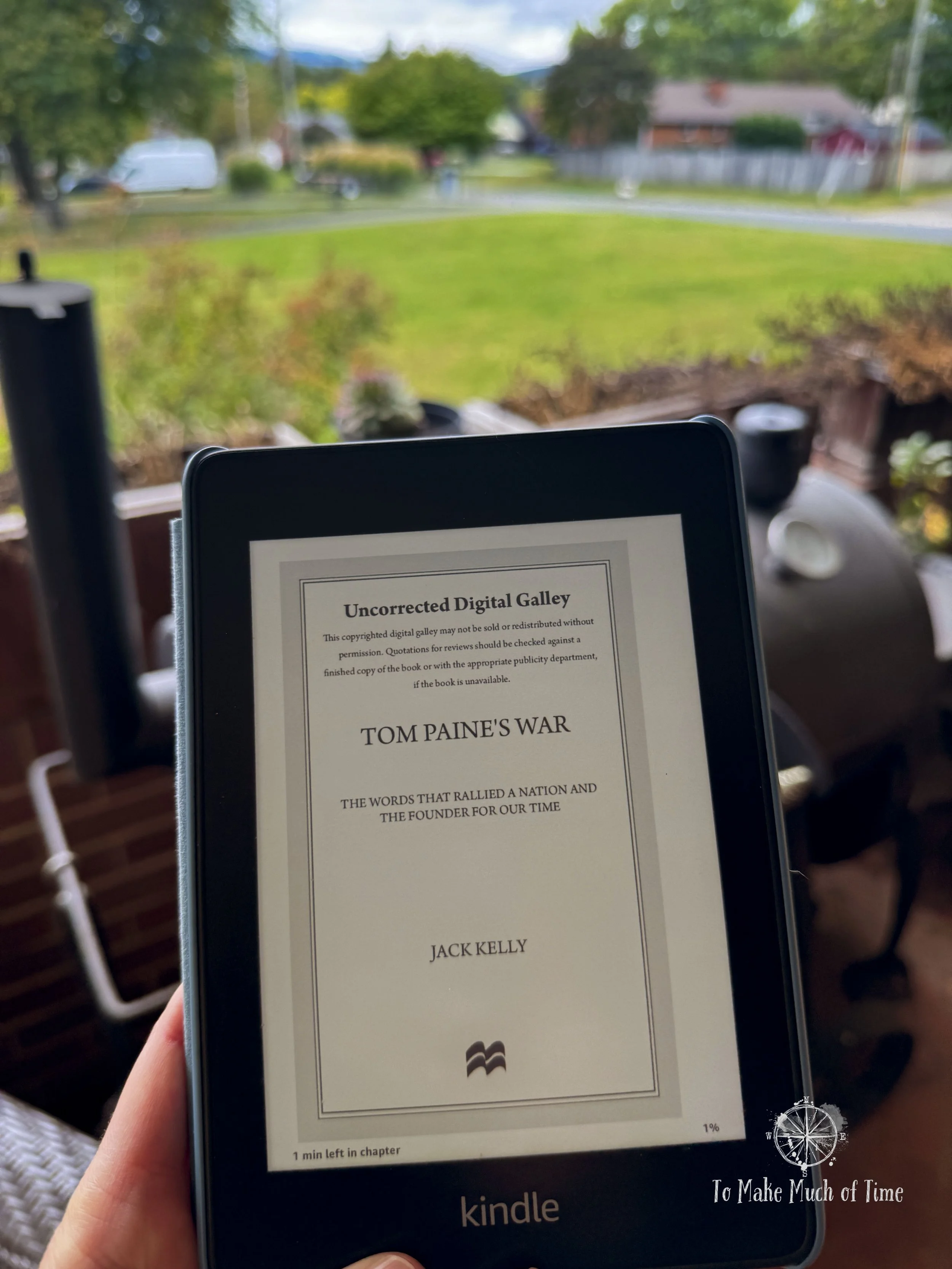Book Review of Tom Paine's War by Jack Kelly
[Disclosure: This review includes affiliate links. Purchases made through the link provide a small commission to us at no cost to you.]
book stats:
352 pages, to be published in January 2026 (I read an Advanced Reading Copy)
you may enjoy this book if you like:
U.S. History * American Revolutionary War * Biographies
travel inspiration:
Tom Paine’s War follows Thomas Paine and his Revolutionary War brethren through the northeast US, primarily in New Jersey and Pennsylvania with many historic sites open to visitors today.
about the author: Jack Kelly
Jack Kelly is a historian and author of six other works: God Save Benedict Arnold (2023) (read our review here), Valcour: The 1776 Campaign That Saved the Cause of Liberty (2021), The Edge of Anarchy: The Railroad Barons, the Gilded Age, and the Greatest Labor Uprising in America (2019), Heaven’s Ditch: God, Gold, and Murder on the Eric Canal (2017), Band of Giants: The Amateur Soldiers Who Won America's Independence (2014), and Gunpowder: Alchemy, Bombards, and Pyrotechnics: The History of the Explosive That Changed the World (2005).
In addition to his historical works, he has written for national publications and has appeared on NPR, PBS, and The History Channel. He is a New York Foundation for the Arts fellow and lives in New York’s Hudson Valley.
review of Tom Paine’s war by jack kelly
Students of American history are aware of Thomas Paine as the author of Common Sense, an important Revolutionary War era tome. But - speaking for myself, an avid reader of history and political science major - I couldn’t have associated anything with Paine beyond his authorship of that one work. So, when I saw Jack Kelly’s work of non-fiction available as an advanced reading copy, I was quick to download it. I had previously read and reviewed Kelly’s work on Benedict Arnold and enjoyed his accessible writing style and telling some of history’s lesser known stories.
The full title of this new book is Tom Paine’s War: The Words that Rallied a Nation and the Founder for our Time. This full title explains Kelly’s two focus areas for the book: first, bringing to life the important and under-valued role Paine played in the American Revolutionary War; and second, addresses why this story is important in our modern era and why Paine isn’t more well known and studied as a true founder of the United States.
Writing an engaging work of history can be quite challenging. The author has facts, often somewhat limited; hopefully a number of first-person accounts to humanize the events as they were seen by those who lived through them; has to bring the tale together in a way that engages a modern reader which requires some artistic license (e.g., imagining the still air on a battlefield and describing it vividly); and is able to tell a multi-dimensional story. The last point is particularly important. In retrospect, history can seem like a series of dates and actions that occurred linearly, but of course we know based on our own lived experience that multiple things happen at once, can trigger additional events in ways that are not always clear-cut, and sometimes understanding the big picture requires zooming way out to see the passage of time.
Kelly succeeds in tackling all these aspects. One approach he takes quite effectively in Tom Paine’s War is to intermingle chapters that provide Paine’s backstory before jumping back in to the action leading up to and during the Revolutionary War. Otherwise, this book could have been a bunch of backstory followed by more history intensive war chapters. Breaking them up for more varied reading is a great technique!
Thomas Paine was clearly a smart and entrepreneurial man, whose life varied between good luck (e.g., Benjamin Franklin wrote him an introductory letter when he emigrated to America, helping him get set up and able to print Common Sense) and cards stacked against him (e.g., in later life, he became a victim of a fervent mixture of politics and religion, ended up being mistakenly viewed as an atheist, and was imprisoned and nearly executed during France’s Reign of Terror).
More than anything, Paine knew how to tap into the sentiment of the everyman, to inspire people to greatness, and how to write for his audience. While many of Paine’s verbose peers had mastery of the written word, Paine purposefully wrote in plain English to be accessible to others. He also understood that the written word was often read aloud in taverns and among colleagues, and so he wrote with the understanding that his words would be spoken, which requires a simpler way of writing.
Kelly makes a compelling case that demonstrates the impact Paine had on the initial revolutionary spirit and also how his later works inspired the hearts of minds of the colonists during the darkest days of the war when their cause appeared to be doomed. Paine was not an academic who wrote from his home but rather joined Washington on the field, capturing descriptions of battle and military movement as it unfolded around him.
Like Benedict Arnold, the focus on the last book of Kelly’s that I read, Thomas Paine has also been ill-served by history for the significant role he played in the early history of the country.
The final chapters and epilogue make clear Kelly’s second reason for writing this book. There are obvious parallels between the factions that emerged in Paine’s latter years and current events in the United States. Any good historian understands that each era is different and that lessons from similar events in the past can be good lessons for the present. Kelly articulated describes the why behind his decision to connect this book to our current times without hitting the reader over the head with a particular viewpoint.
For anyone who enjoys reading non-fiction about early US history and warfare, I highly recommend Tom Paine’s War.
Click on the image below to save this post to Pinterest!
Check out our other reviews about works of non-fiction.





